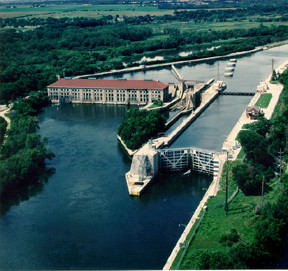Chicago Sanitary and Ship Canal
The Chicago Sanitary and Ship Canal (CSSC) is a significant waterway in the state of Illinois, United States. It connects the Chicago River to the Des Plaines River and is part of the Illinois Waterway system. The canal was constructed to address sanitation issues in Chicago and to provide a navigable route for ships.
History[edit | edit source]
The construction of the Chicago Sanitary and Ship Canal began in 1892 and was completed in 1900. It was built by the Sanitary District of Chicago, now known as the Metropolitan Water Reclamation District of Greater Chicago. The primary purpose of the canal was to reverse the flow of the Chicago River, which originally flowed into Lake Michigan. This reversal was necessary to prevent the city's sewage from contaminating the lake, which was the source of drinking water for Chicago.
Engineering and Construction[edit | edit source]
The canal is approximately 28 miles (45 km) long, 202 feet (62 m) wide, and 24 feet (7.3 m) deep. It was one of the largest civil engineering projects of its time and involved the excavation of millions of cubic yards of earth and rock. The canal's construction required innovative techniques and equipment, including steam-powered dredges and dynamite for blasting through limestone.
Environmental Impact[edit | edit source]
The reversal of the Chicago River had significant environmental impacts. It helped to improve public health in Chicago by reducing waterborne diseases such as cholera and typhoid fever. However, it also altered the natural flow of water between the Great Lakes and the Mississippi River basin, leading to ecological changes in both regions.
Modern Use[edit | edit source]
Today, the Chicago Sanitary and Ship Canal is used for both sanitation and navigation. It is a critical component of the Illinois Waterway, which provides a navigable route from the Great Lakes to the Gulf of Mexico via the Mississippi River. The canal also plays a role in flood control and wastewater management for the Chicago metropolitan area.
Invasive Species[edit | edit source]
The canal has been a pathway for invasive species, such as the Asian carp, to enter the Great Lakes. Efforts to prevent the spread of these species include the installation of electric barriers and other control measures.
See Also[edit | edit source]
- Chicago River
- Des Plaines River
- Illinois Waterway
- Metropolitan Water Reclamation District of Greater Chicago
- Asian carp
References[edit | edit source]
External Links[edit | edit source]
Search WikiMD
Ad.Tired of being Overweight? Try W8MD's physician weight loss program.
Semaglutide (Ozempic / Wegovy and Tirzepatide (Mounjaro / Zepbound) available.
Advertise on WikiMD
|
WikiMD's Wellness Encyclopedia |
| Let Food Be Thy Medicine Medicine Thy Food - Hippocrates |
Translate this page: - East Asian
中文,
日本,
한국어,
South Asian
हिन्दी,
தமிழ்,
తెలుగు,
Urdu,
ಕನ್ನಡ,
Southeast Asian
Indonesian,
Vietnamese,
Thai,
မြန်မာဘာသာ,
বাংলা
European
español,
Deutsch,
français,
Greek,
português do Brasil,
polski,
română,
русский,
Nederlands,
norsk,
svenska,
suomi,
Italian
Middle Eastern & African
عربى,
Turkish,
Persian,
Hebrew,
Afrikaans,
isiZulu,
Kiswahili,
Other
Bulgarian,
Hungarian,
Czech,
Swedish,
മലയാളം,
मराठी,
ਪੰਜਾਬੀ,
ગુજરાતી,
Portuguese,
Ukrainian
Medical Disclaimer: WikiMD is not a substitute for professional medical advice. The information on WikiMD is provided as an information resource only, may be incorrect, outdated or misleading, and is not to be used or relied on for any diagnostic or treatment purposes. Please consult your health care provider before making any healthcare decisions or for guidance about a specific medical condition. WikiMD expressly disclaims responsibility, and shall have no liability, for any damages, loss, injury, or liability whatsoever suffered as a result of your reliance on the information contained in this site. By visiting this site you agree to the foregoing terms and conditions, which may from time to time be changed or supplemented by WikiMD. If you do not agree to the foregoing terms and conditions, you should not enter or use this site. See full disclaimer.
Credits:Most images are courtesy of Wikimedia commons, and templates, categories Wikipedia, licensed under CC BY SA or similar.
Contributors: Prab R. Tumpati, MD

